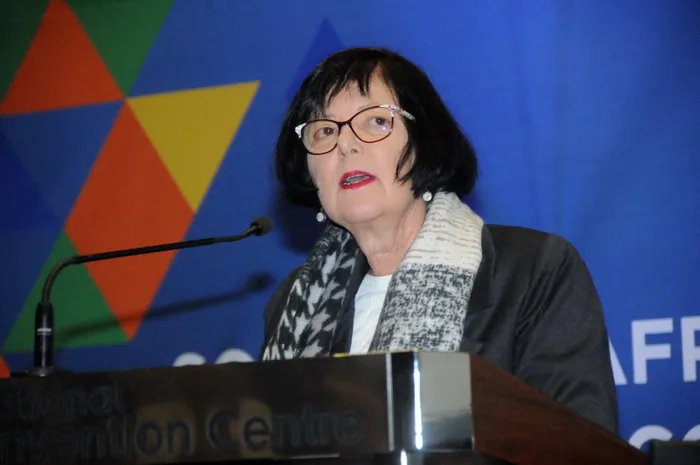Creecy unveils six key targets to enhance South Africa’s transport capabilities
ECONOMY

Transport Minister Barbara Creecy speaking at the 2025 Southern African Transport Conference (SATC) in Pretoria on Monday.
Image: Supplied
Banele Ginidza
Transport Minister Barbara Creecy has unveiled a bold strategy aimed at improving South Africa's transport sector's freights and goods handling capacity and to transform the passenger, freight, and aviation sectors over the next four years.
Speaking at the 2025 Southern African Transport Conference (SATC) in Pretoria on Monday, Creecy said the first target was to increase freight volume on the Transnet network to 250 million tons annually by 2029, a move that is expected to strengthen the backbone of South Africa's logistics framework.
Addressing port efficiency, Creecy also said South Africa aimed to achieve an international operational benchmark of 30 gross crane movements per hour when loading and unloading vessels, a standard necessary for remaining competitive in global markets.
“We need to achieve this standard to remain globally competitive,” Creecy noted.
Passenger transport also features prominently in Creecy's strategy, with a commitment to ensure that the passenger rail system provides safe, reliable, and affordable transport.
The goal is to achieve 600 million passenger journeys per annum by 2030, underpinned by an extensive revitalisation of the rail network.
By the end of May 2025, the Passenger Rail Agency of South Africa (Prasa) aims to reopen 35 out of 40 passenger corridors, resulting in an expected increase in journeys from 77 million last year to 116 million by 2025/26.
The aviation sector is also poised for significant enhancements with a projected increase to 42 million passengers annually moving through the Airports Company South Africa (Acsa) network by the end of Creecy's current political term.
To facilitate this growth, Creecy announced that R21.7 billion has been allocated to the Airports Company South Africa (Acsa) for infrastructure development, which includes modernising passenger facilities and constructing a new freight terminal at OR Tambo International Airport.
Highlighting the economic role of South African Airways (SAA), Creecy said a recent Oxford Economics Africa study confirmed SAA contributed R9.1bn to the GDP in 2023/24, with projections rising to R32.6bn by 2029/30.
Creecy said SAA was set to support 86 700 jobs by the end of this term, up from 25 000 at present.
To solidify South Africa's standing in regional and international trade, a target of 1.2 million tons of airfreight per annum through Acsa airports has also been set. This initiative positions the country as a vital player in the logistics landscape.
The sixth – and most critical – target is to reduce road fatalities by 45% by 2029, in line with the United Nations (UN) goal of halving road deaths by 2030.
Creecy praised the progress made so far, reporting a consistent 9% annual decline in accidents and fatalities, but emphasised the need to intensify efforts to reduce pedestrian deaths, which account for 44% of fatalities.
With a keen focus on the rail industry, Creecy reiterated the department’s commitment to rejuvenating rail transport as a primary means of moving people and goods.
She reaffirmed that rail is poised to be a central pillar of the transport infrastructure, urging the need for increased private sector investment as state resources are limited.
“To guide private sector investment in our five priority rail and port corridors, we have just concluded a Request for Information process,” she said.
Creecy also confirmed the establishment of the Private Sector Participation Unit at the Development Bank of Southern Africa (DBSA), which will help direct private investment into rail and port infrastructure.
On road infrastructure, Creecy acknowledged public concerns, noting that the SA National Roads Agency (Sanral) has taken over 3 099 kilometres of provincial roads at the request of premiers and has reprioritised funding to ensure these roads are maintained.
However, she cautioned that Sanral cannot take on further upgrades without overburdening its budget.
To strengthen oversight, Creecy announced that R94 million has been allocated to provide technical support to provincial road departments. She also revealed a new Memorandum of Understanding with the South African Local Government Association (Salga) to monitor spending on the Municipal Infrastructure Grant.
On the taxi industry, which transports more than 85% of commuters, Minister Creecy emphasised the need for formalisation and the elimination of criminality.
“We are working with banks and vehicle manufacturers to de-risk financing and develop a Standard Operating Procedure for issuing operating licences,” she said.
“A fully integrated transport system lies at the heart of any nation’s development. It is the artery through which progress flows, connecting communities, facilitating trade, and enabling access to opportunities. Our responsibility – as role players in the transport sector – is immense.”
BUSINESS REPORT